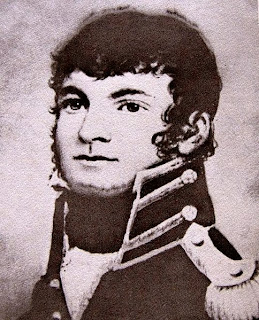by Tom Castaldi
 |
| Wells |
William Wells was one of the most
extraordinary figures ever associated with the Fort Wayne region. Known along the frontier as a “white Indian,”
he led a life that was the product of two cultures. Unable ultimately to choose one or the other,
he consequently was never fully accepted by either. In the end, he died in battle dressed and
painted as a Miami warrior while defending whites.
Born in 1770, Wells had been captured as a
sixteen year-old boy by Miami warriors raiding in Kentucky. He was adopted by Chief Graviahatte – or the
Porcupine – taught Indian ways and was given the name “Apekonit.” An old tale has it that the name means Wild
Carrot and had to do with his red hair, however, wild carrots are white in
color. Another more probable story says
that Wells was famished after the long journey to reach to the Three Rivers
region where his captors offered him food to eat. He devoured a great quantity with such gusto
that he was then and there given the name of a soup he ate, which was made from
the wild carrot.
He proved himself an able young warrior in
raids against pioneer settlements. So
attached did Wells become to his new Indian family that no attempt to lure him
back to Kentucky succeeded. Wells
married a Wea woman and together they produced a son. Later he participated in the
early battles led by Miami War Chief Little Turtle against the United States
forces. In return, U.S. soldiers raiding
in the lower Wabash River valley captured Well’s wife and child and took them
as hostages to Fort Washington which is present-day Cincinnati. This was one reason Wells abandoned the
Indian cause and joined the U.S. military camp.
William Wells
subsequently was wedded to Manwangopath
– Sweet Breeze – the daughter of Little Turtle.
In 1794, Wells served Major
General Anthony Wayne as his “chief of spies,” or head scout, in the general’s
campaign against Indian resistance. He, along with other “white Indians,” led
the scouts in daring spying raids on the camps of the Shawnee War Chief Blue
Jacket and his allies, bringing Anthony Wayne valuable information that helped
the Americans win the Battle of Fallen Timbers on August 20, 1794.
Wells had a stormy
career as Indian Agent and Interpreter in the many negotiations between the
Indians and the government. A staunch supporter of Indian rights, William
Wells, along with his friend and father-in-law, Little Turtle, struggled to
help the Miami keep as much of their land as they could in the treaty
settlements that followed the wars.
Between 1796 and 1809, he accompanied Chief Little Turtle on his four
trips to the nation’s capital.
A tract of 320
acres of land extending west of the St. Joseph River – known as Wells’
Preemption, the modern Bloomingdale and Spy Run neighborhoods – was set aside by
an act of Congress in 1808 for Wells in recognition of his many services to the
U.S. Government. This established Wells’
right to occupy and develop the land with an option to buy it at $1.25 an acre
– rather than having to bid for the land, as was usually the case – when the
area was opened for land sales by the U.S. Land Office. Wells created on these lands a farm that was
worked by twelve African-Americans, who were held as slaves through lifetime
indentures, contrary to the prohibition of slavery declared in the Northwest
Ordinance of 1787. Present-day Spy Run
Avenue and Spy Run Creek, which run through Wells’ Preemption, are named for
William Wells in remembrance of his role as Anthony Wayne’s “Chief of Spies.”
As a result of
aggressive United States treaty demands between 1803 and 1809, new Indian
resistance developed under the leadership of the Shawnee Tecumseh and his
brother, the Prophet. In 1812, William
Wells volunteered to go to Fort Dearborn – present-day Chicago – to provide
safe passage for the small garrison there back to the stronger Fort Wayne. Through sensing the great danger, Wells
obeyed orders and led the small troop of soldiers, women, and children back
toward Fort Wayne in August 1812. After
traveling only a short distance from the fort, the wagon train was attacked by
a large band of Potawatomi. Defending a
wagon full of children, William Wells was cut down by musket fire. The Indians
cut off his head and, as a show of honor for a great warrior, ate his heart on
the spot.
This article originally appeared in Fort Wayne Magazine “Along the Heritage
Trail with Tom Castaldi” – Oct 2006 No. 27.
Allen County
Historian Tom Castaldi is author of the Wabash & Erie Canal Notebook
series; hosts “On the Heritage Trail,” which is broadcast at 6:35 a.m., 8:35
a.m. and 6:30 p.m. Mondays on WBOI, 89.1 FM; and “Historia Nostra” heard on
WLYV-1450 AM and WRRO 89.9 FM. Enjoy his previously published columns on the
History Center’s blog, “Our Stories,” at history centerfw.blogspot.com